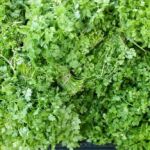| Common Name: |
Chervil |
| Botanical Name: |
Anthriscus cerefolium |
| Genus: |
Anthriscus |
| Family: |
Apiaceae |
| Native Location: |
Europe, W Asia |
| Cultivation: |
Rich, light, moisture-retentive soil in partial shade. For a winter crop in cold areas, chervil may be protected with cloches, grown under cover, or grown in a cold frame. It bolts in high temperatures and dry, sunny positions. Chervil is reputed to give radishes a sharper flavor if planted beside them. May protect lettuce from ants and aphids, and repel slugs. |
| Propagation: |
By seed sown at intervals or 3-4 weeks from early spring to early autumn, and thinned to 20cm (8in) apart. Seeds are viable for about a year. |
| Harvest: |
Leaves are cut before flowering and usually fresh. If storage is required, it is better to freeze than to dry them. |
| Height: |
30-60cm (12-24in) |
| Width: |
23-30cm (9-12in) |
| Hardiness: |
Z3-8 |
| Parts Used: |
Leaves |
| Properties: |
A bitter, aromatic herb that acts as a cleansing tonic, especially for liver and kidney functions, and as an expectorant. |
| Medicinal Uses: |
Internally for fluid retention, rheumatism, eczema, and jaundice. Externally for conjunctivitis, inflamed eyelids, and also for hemorrhoids. |
| Culinary Uses: |
Leaves are added to dishes based on potatoes, eggs or fish, especially in French cuisine. It is an essential ingredient of ravigote sauces and fines herbes. The delicate anise flavor does not withstand drying or prolonged cooking; chervil is therefore usually added just before serving. It is also used raw in salads and as a garnish, in sprigs or finely chopped. Flowers and roots are also edible. |
| Bibliography: |
Encyclopedia of Herbs by Deni Brown Copyright © 1995, 2001 Dorling Kindersley Limited. Pg 124 |

